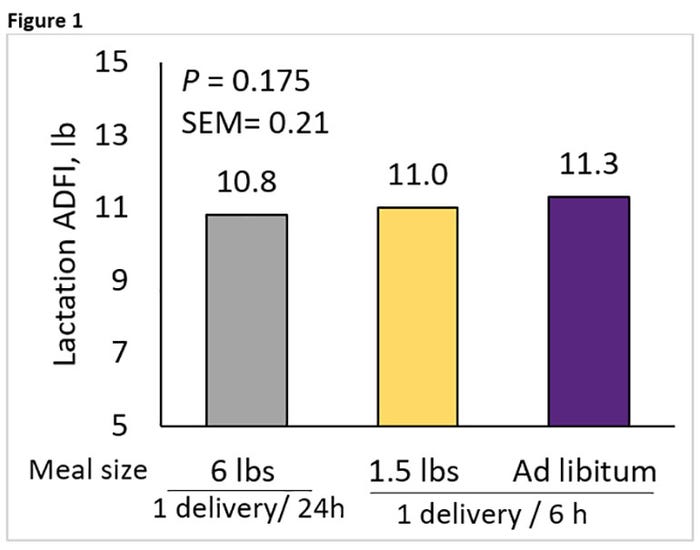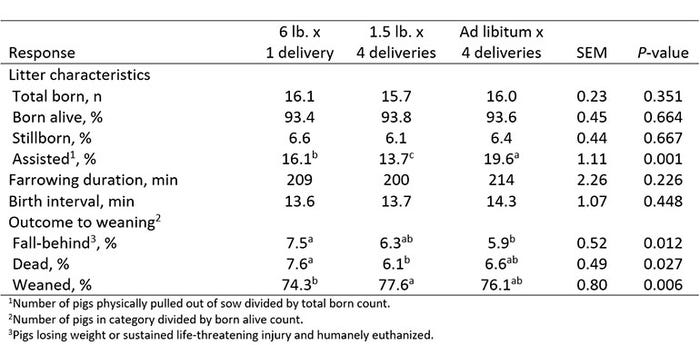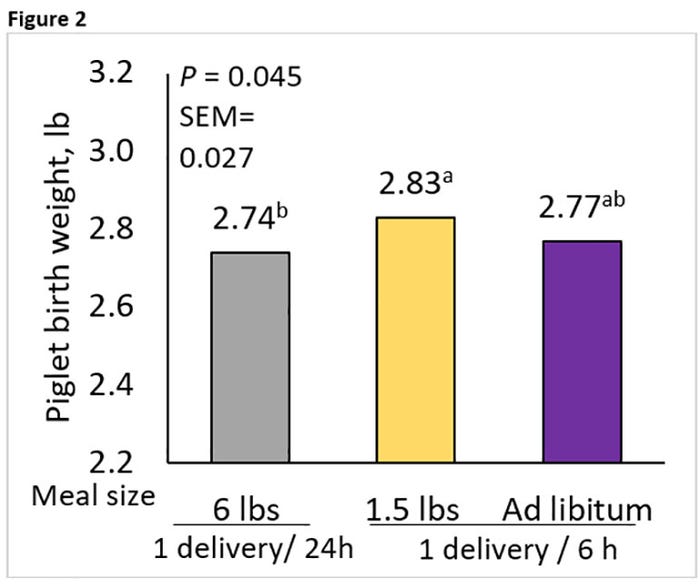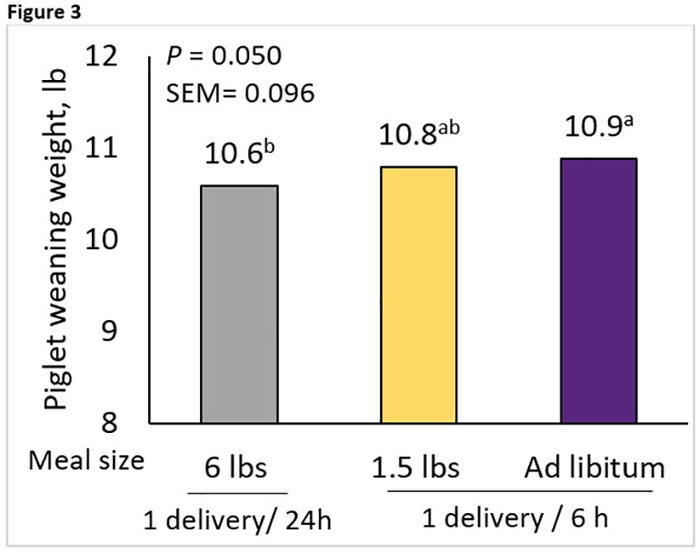Feeding lactation diets to sows ad libitum for three days prior to farrowing increased weaning weight compared to sows fed once daily prior to farrowing.
May 14, 2020

Farrowing duration has naturally increased as genetic selection continues for larger litter size. While the average farrowing duration is approximately four hours for a litter of 15 pigs, it can range from 30 minutes up to 12 hours to complete.
Longer farrowing durations can have negative effects on sow health and survival of piglets during parturition and lactation. Longer farrowing durations have been associated with greater asphyxia (lack of oxygen) in piglets resulting in stillbirths, or negatively impacting live born piglet growth and survivability beyond the first few hours of life.
A previous study suggests that when sows had been offered a meal three hours or less before she started farrowing, she had a shorter farrowing duration and decreased need for farrowing assistance compared to sows that had been offered their last meal greater than six hours prior to farrowing. It was hypothesized that this was due to higher blood glucose levels at the start of farrowing, which allowed for a more readily available energy source to use during farrowing and maintain contractions.
Currently, commercial farms utilize many different feeding management strategies once sows are moved into farrowing crates until the onset of farrowing, such as feeding one set feed amount in the morning, two smaller meals twice daily, ad libitum or other combinations. However, is there a feeding strategy that should be used pre-farrowing to minimize farrowing duration and improve the number of live-born piglets?
The objective of this study was to determine whether the amount of feed or frequency of feed delivery would affect the farrowing process, sow and litter performance, and survivability of piglets. A total of 727 sows (Large white × Landrace) were used at a commercial sow farm in southern Minnesota (New Fashion Pork, Jackson, Minn.).
On the day of gestation when sows entered the farrowing house (Day 113 ± 2), sows were weighed and allotted to one of three feeding management strategies. Feeding strategies consisted of: 1) sows fed 6 lbs. (1.15% standardized ileal digestible lysine and 1,150 Kcal/lb. NE) lactation diet once daily at 0700 hours; 2) sows fed 6 lbs. lactation diet four times daily in 1.5 lb. meals (0100 hours, 0700 hours, 1300 hours, 1900 hours); and 3) sows fed ad libitum lactation diet, made to stand, and encouraged to consume meals four times daily (0100 hours, 0700 hours, 1300 hours, 1900 hours).
When sows entered the farrowing house each day (1300 hours), treatments 2 and 3 were fed their first meal, whereas Treatment 1 did not receive their first meal in the farrowing house until the following morning. Prior to entry to the farrowing house, sows were fed 4.5 lbs. of gestation diet daily. All feeding strategies were administered via hand feeding from a feed cart equipped with a scale until the start of farrowing. Sows were not fed during farrowing; however, upon completion of the farrowing process, all sows were fed lactation diet ad libitum until weaning.
During farrowing, sows were continuously monitored for 24 hours. Farrowing assistance was provided after 30 to 45 minutes with no farrowing progress evidence from the time a previous pig was born. The farrowing process was complete when no new pig had been born after one hour and placenta expulsion observed.
Sow body weight at weaning was 7 pounds heavier in sows that had been fed ad libitum prior to farrowing, compared to sows that had been fed 1.5 lbs. every six hours prior to farrowing. As a result, sows that consumed feed ad libitum prior to farrowing had reduced sow body weight loss from post-farrow to weaning compared to sows fed 1.5 lbs. every six hours (-8.4 lbs. vs. -11.4 lbs.), with sows fed 6 lbs. once daily being intermediate. Similar to the changes observed for body weight, sow backfat loss was reduced in sows fed ad libitum compared to sows fed 1.5 lbs. every 6 hours (-1.9 mm vs. 2.7 mm), resulting in greater backfat at weaning in sows fed ad libitum prior to farrowing compared to sows fed 1.5 lbs. every six hours. The reduction in backfat and body weight loss is likely a result of increased feed consumption during the peripartum period (21.4 vs. 16.5 lbs.) and improved feed intake during the lactation period when sows were fed ad libitum (Figure 1). This change in feed intake could be due to a change in feeding behavior by allowing sows to determine their feed intake prior to farrowing, rather than restricted feeding.

It is important to note that ad libitum feed intake prior to farrowing did not exceed seven days. In previous studies that evaluated ad libitum or increased feeding strategies starting on Day 90 of gestation, excess body weight and backfat gain occurred which contributed to decreased feed intake and increased sow body lipid mobilization in lactation.
There was no evidence that total born pigs, percentage of pigs born alive or stillborn were different due to feeding strategy (Table 1). There were differences in percentage of pigs assisted per sow where sows fed ad libitum prior to farrowing had the highest percentage assistance, followed by sows fed once daily prior to farrowing, with those receiving 1.5 lbs. every six hours having the lowest assistance rate. Farrowing duration and birth interval were similar across feeding strategies.

Average piglet birth weight was greater for born alive piglets in sows fed 1.5 lbs. every six hours prior to farrowing compared to those fed 6 lbs. once daily, with those fed ad libitum prior to farrowing intermediate (Figure 2). There was no evidence for difference in colostrum yield or intake, which resulted in similar 24 hour litter weights and litter gain in the first 24 hours. At weaning, pigs from sows fed ad libitum prior to farrowing were heavier compared to sows fed 6 lbs. once daily prior to farrowing (Figure 3). This may be explained by the numerically increased feed intake during lactation in sows fed ad libitum prior to farrowing resulting in greater milk output and improved piglet weaning weights.


Percentage of fall-behind pigs were reduced in sows fed ad libitum prior to farrowing compared to those fed once daily prior to farrowing, with those fed 1.5 lbs. every six hours intermediate. Piglet mortalities from 24 hours to weaning were reduced in sows fed 1.5 lbs. every six hours compared to those fed once daily prior to farrowing. Although litter size at weaning was similar across treatments, the total percentage of pigs weaned was increased in those fed 1.5 lbs. every six hours prior to farrowing compared to those restricted to 6 lbs. once daily, with ad libitum fed sows being intermediate.
This result suggests that feeding strategy prior to parturition may have an impact in the sow's ability to raise her piglets to weaning. There was no evidence for difference in wean-to-estrus interval, percentage of females in estrus by Day 7 or 20 after weaning, conception rate or farrowing rate.
In summary, it is important to consider the length of time of ad libitum feeding prior to farrowing, where the benefits in lactation feed intake, reduction in backfat loss and improvements in litter growth can be observed. Feeding the lactation diet to sows ad libitum for an average of three days prior to farrowing increased weaning weight compared to sows fed once daily prior to farrowing. Sows limit-fed four times daily prior to farrowing had the lowest farrowing assistance and increased weaned percentage compared to sows fed one meal daily prior to farrowing.
With levels of sow productivity in this study, there was no evidence feeding strategies from entry to the farrowing house until farrowing impacted farrowing duration, birth interval or stillborn rate.
This project was part of the Improving Pig Survivability project. This is a five-year, interdisciplinary, multi-university project funded by the National Pork Board and Foundation for Food and Agriculture Research aimed at reducing mortality in the U.S. swine industry.
Sources: Kiah M. Gourley, Jason C. Woodworth, Joel M. DeRouchey, Mike D. Tokach, Steve S. Dritz, and Robert D. Goodband, who are solely responsible for the information provided, and wholly own the information. Informa Business Media and all its subsidiaries are not responsible for any of the content contained in this information asset.
You May Also Like



